In social science research, a model is a tentative description of what a social process, say the communication process or a system might be like. It is a tool of explanation and analyses, very often in a diagrammatic form, to show how the various elements of a situation being studied relate to each other. Models are not statements of reality. Only after much further research and testing would the model is considered viable. It could then be developed into a theory. The term model can also refer to a particular process or object, which is used as a point of reference, when an attempt to explain the unknown is being made. It comprises involving an analogy to throw up the similarities between the phenomena to be explained and one, which is well known, i.e. the model.
Additionally the model can be a person whose behaviour others wish to emulate or who they wish to model themselves after.
The simplest definition of a model is that it is an analogue. A model is a relatively well-developed analogy. Given two objects or processes, which are dissimilar in many respects, one is an analogue of the other to the extent that the physical or logical structure of one re-presents the physical or logical structure of the other.
The advantage of models in communication research is that it allows the researcher to account for different variables in different communication situations. Models only represent systems or processes. Since they are not real, they are just symbolic ways of looking at systems to help us to think about them more lucidly. Again since models do not show every part of a system, they are usually incomplete in that sense. Even those that are shown are represented only in enough detail to help us look at the processes or features in which we are interested. Mo0dels give us an idea of complicated objects or events in a general way. They enable us to see how a particular communication event fits into the general pattern. They provide a classification for an orderly nature of events and suggest new ways of looking at old problems, and familiar events. They help us by providing a structure of reference for purposes of study. Theories are not models and the most fundamental difference between a theory and a model is that the former is an explanation whereas the latter is a representation.
Communication Models
Fig.1. Aristotle's Model of Communication
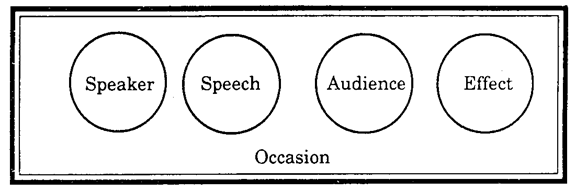
Fig.1. Aristotle Model
Aristotle’s Model of Communication (Devito, 1978)
The earliest model of communication was the symmetrical and simple model developed by the great Greek philosopher Aristotle some 2000 years before. Aristotle in his model includes the five essential elements of communication, i.e., the speaker, the speech or message, the audience, the occasion, and the effect. In his rhetoric, Aristotle advises the speaker on constructing a speech for different audiences on different occasions for different effects. This model is most applicable to public speaking.
2. Lasswell's Model (1948)
Lasswell has given us another simple model. His model belongs specifically to the area of mass communication. He argued that to understand the process of mass communication one needs to study each of the stages in his mode. "Who says what, in which channel, to whom, and, with what effect."
Fig.2. Lasswell's Model

(Source: Public Opinion and Propaganda by Harold Lasswell, 1948)
This is the verbal version of Shannon and Weaver's original model. It is linear. It sees communication as the transmission of message. It raises the issue of the effect rather than meaning. Effect implies an observable and measurable change in the receiver that is caused by identifiable elements in the process. A change in one of these elements will change the effect. We can change the encoder. We can change the message. We can change the channel, and each one of these changes would produce the appropriate change in the effect. Most mass communication research has implicitly followed this model.
The work of institutions and their process on the producers of communication on the audience and how it is affected clearly derives from a process based linear model.
Lasswell's model - comments
Until the 1960s Lasswell's four questions (of who says what, by what channel, to whom and with what effect) dominated studies of the mass media in France. Not only his exemplary expression defines the different research areas for communication investigations, but also seemed to prescribe the appropriate concepts and methodological orientation to be followed. Thus, Lasswell's paradigm served the entire scientific community of communication scholars.
Fig.3.Lasswell's Communication Model
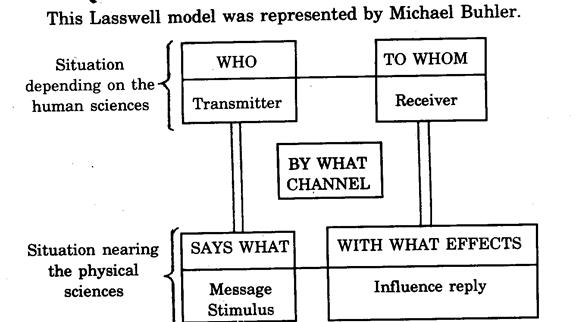
It was Harold Lasswell who first precisely delineated the various elements, which constitute a "communication fact." According to him, one cannot suitably describe a "communication action" without answering the following questions: who said what, by what channel, to whom and with what effect?
Identification of transmitters, analysis of message content, study of transmission channels audience identification and evaluation of effects; these are the five parameters of communication studies. Michel Buhler represents the Lasswell model with the above diagram.
Along with other developments during this period were a number of writings that sought to provide description of the nature of the communication process. One of the most often cited political scientists Harold Lasswell advanced characterization communication in 1948 as an outgrowth of his work in the area of propaganda. Lasswell provided a general view of communication that extended well beyond the boundaries of political science. Lasswell's view of communication, as had Aristotle has some two thousand years earlier, focused primarily on verbal messages. It also emphasized the elements of speaker, messages, and audience, but used different terms. Both men viewed communication as a one way process in which one individual influenced others through messages. Lasswell offered a broadened of definition channel to include mass media along with verbal speech as a part of the communication process. His approach also provided a more generalized view of the goal or effect of communication than did the Aristotelian perspective. Lasswell's work suggested that there could be a variety of outcomes or effects of communication such as to inform, to entertain, to aggravate and to persuade (Brent, 1984).
3. Shannon and Weaver Model (1949)
The preconceptions of the academic field of mass communication were heavily influenced by the engineering model of Shannon and Weaver (1949) Communication was conceived as a linear act of transmission of a message from a source to a receiver via a signal producing transmitter. A component called 'noise' acknowledged the presence of context in the electrical engineering model.
Fig. 4. Shannon and Weaver Model

Shannon and Weaver’s mathematical theory of communication (1949) is widely accepted as one of the main seeds out of which communication studies have grown. It is a clear example of the process school, seeing communication as the transmissions of messages. The work developed during the Second World War in the Bell telephone laboratories in the US and their main concern was to work out ways in which channels of communication could be used most efficiently. For them, the main channels were the telephone, cable and the radio wave. They produced a theory that enabled them to approach the problem of how to send a maximum amount of information along a given channel to carry information. This concentration on the channel and its capacity is appropriate to their engineering and mathematical background, but they claim that their theory is widely applicable over the whole question of human communication.
Shannon and Weaver's model (1949) presents communication as a linear process. Its simplicity has attracted many derivatives, and its linear process centered nature has attracted many critics. It’s obvious characteristics of simplicity and linearity standout clearly.
Fig.5. Shannon and Weaver Communication Model
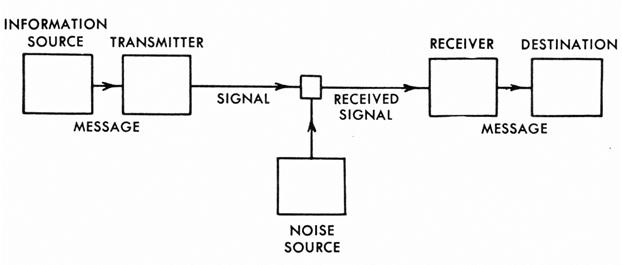
(Source: The Mathematical theory of communication. Claude E. Shannon and Warren Weaver, 1949).
Claude Shannon and Warren Weaver gave this model. As the diagram above indicates, this communication model comprises four elements. A source of information, with a greater or lesser number of messages to communicate; a transmitter or sender with the capacity to transform a message into a signal; a receiver which decodes the signal in order to retrieve the initial message, and finally, the destination, a person or thing for whom the message is intended. Communication, according to this model, follows a simple left to right process. The information source (say speaker), selects a desired message from all the possible messages. The message is sent through a transmitter (microphone) and is changed into signals. A receiver (say earphone), changed back into a message and given to the destination, a listener, receives the signals. In the process of transmission, certain distortions are added to the signal which are not part of the message and these will be called noise.
The basis of all contemporary Western theories of Communication - Shannon- Weaver model stresses the idea of inside and outside and assumes that communication is a lineal matching rather than making. The information source changes the message into the signal, which is actually sent over the communication channel from the transmitter to the receiver. In the case of telephony the channel is a wire the signal a varying electrical current on this wire, the transmitter is the set of devices (telephone transmitter etc.) which change the sound pressure of the voice into the varying electric current. In oral speech, the information source is the brain, the transmitter is the voice mechanism producing the varying sound pressure (the signal) which is transmitted through the air (the channel). In radio, the channel is simply space, and the signal is the electromagnetic wave, which is transmitted. The receiver is an inverse transmitter, changing the transmitted signal back into a message and handing this message on to the destination.
In the process of being transmitted, usually certain things are added to the signal, which were not intended by the sender. These additions are distortion of sounds as in telephony, or static in radios, or errors in transmission in telegraphy or facsimile etc., Such changes in transmission signals are called noise.
Shannon and Weaver's Model (1949) comments
Both European and American scholars recognize that Shannon and Weaver's (1949) model provided the basic paradigm for effects-oriented communication research by setting forth the main elements (source, channel, messages, receiver) of a simple linear model of communication. This model became tremendously popular with communication researchers enabling the field of communication study to take off' about 30 years ago. It formed the main paradigm around which invisible college of communication researcher formed. Less well known is the contribution by Shannon and Weaver in defining the concept of information as a central notion for the field of Communication. Shannon and Weaver's model was used in the field of electronics for many purposes, form the design of telephone networks to matrices of computer memories. An eminent Finnish scholar between the two central concept (a) communication (b) informations has identified an important distinction. These two concepts trace from Aristotle to the Shannon and Weaver mathematical theory of a single transmission and to other models of information and communication. Although Shannon and Weaver's concept of the probabilistic model of communication has been fruitful in leading to further research, it was never intended to describe linguistic information and human communication. (Source: Everett Rogers and Francis Balle, 1985).
http://www.youtube.com/watch?v=2UzlE19Ui2s&feature=player_detailpage
4.C.E. Osgood - Schramm Model (1975)
To the circular model, we have added boxes and arrows showing the influence of noise and personality are a helix used as a model by Frank E.X. Dance. He felt that circular models were better than straight - lines ones like Shannon- Weaver, but that they had a built in error since they showed communication ending up where it started off. In fact as an act of communication goes on, the noise gets less (because the communicators get more used to handling the channel / model) and personality becomes more helpful (because, as communicators get to know each other and the subject, they adjust to each other and fill gaps in their knowledge).
Fig .6.C.E. Osgood-Schramm Communication model
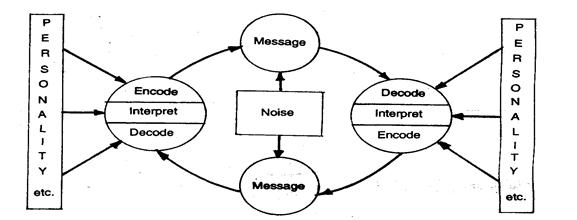
5. Katz and Lazarfeld's Model (1955)
The model of 1955 was based on earlier research in which they found that information presented on the mass media did not have the reach and impact upon the receivers as previous views of communication seemed to suggest it would. Specifically their research indicated that political radio and print messages seemed to have a negligible effect on individuals voting decisions.
Their research also indicated that some people were consistently more influential than others, leading them to conclude that ideas often seemed to flow from radio to print to opinion leaders and from them to the less active sections of the population - in a two-step flow.
Fig.7. Katz and Lazarfeld's Model

(Source: Personal influence by Eliha Katz and Paul Lazarfeld, 1955)
6. David Berlo's Model (1960)
In the last twenty-five years, a number of models of communication have been developed by communicologists, each one expanding the earlier presentation. David Berlo's model is one among them, which has been profusely quoted and frequently mentioned in discussions. In his book, “The Process of Communication” written in 1960, he presented this model which has a close similarity to the earlier Aristotelian model, including the traditional elements of source, message, channel and receiver. Berlo's model attempts to explain the various components in the communication process. For each of these basic components, controlling factors were listed.
For each of these four components there are five elements that need to be considered. The source and receiver are treated in essentially the same way. To study either we need to consider their communication skills (speaking and writing for the source and listening and reading for the receiver) their attitudes, their knowledge, the social system of which they are a part and the culture in which they operate. The message consists of both elements and structure, each of which may be broken down into content, treatment and code. For the channel, Berlo lists the five senses, emphasizing that the messages may be sent and received by any and all of the senses.
Fig. 8. David Berlo's Model
Berlo more than the others emphasized the idea that communication was a process, and the idea that “meanings are in people, not in words….”

(Source: "The process of communication - An Introduction to Theory and Practice" by David Berlo, 1960).
His model reinforced a shift away from views of communication that emphasized the transmission of information to perspectives that focused on the interpretation of information. Berlo writes, “People can have similar meanings only to the extent that they have had similar experiences”. Berlo also felt that human communication always had a purpose "our basic purpose in communication is to become an affecting agent, to affect others, our physical environment, and ourselves. We communicate to influence to affect with intent".
7. Rogers and Kincaid Model (1981)
One of the more recent models of the communication process is provided by Everett Rogers and D. Lawrence Kincaid (1981). The authors described what they termed a convergence model of communication that stressed the importance of information and the manner in which information links individuals together in social networks. They described communication as a process in which individuals create and share information with one another in order to reach mutual understanding. This cyclical process involves giving meaning to information that was exchanged between two or more individuals as they move towards one another, and to unite in a common interest or focus. In explaining the matter in which the convergence process was thought to operate, they indicated that communication always begins with "and then---" to remind us that something has occurred before we begin to observe the process. Participant A may or may not consider the past before he shares information (I1) with participant B. This individual must perceive and then interpret the information which A creates to express his/her thoughts, and then B may respond by creating information (I2) to share with A Individual. A interprets this new information and then may express himself again with more information (I3) about the same topic. Individual B interprets this information, and they continue the process (I4……In) until one or both become satisfied that they have reached a sufficient mutual understanding of one another about the topic for the purpose at hand. As in a number of early views, the convergence model explained communication in terms of a progressive sending and receiving messages between tow individuals in which the goal and predicted outcome are mutual understanding of a topic. Although acknowledging the role of interpretive process that occur within individuals, the Rogers and Kincaid view emphasised the information exchanges and networks them. Their perspective also carried forth the view of communication as a process rather than a single event, a point of view emphasized in nearly all models in recent years.
Fig.9. Rogers and Kincaid Communication Model
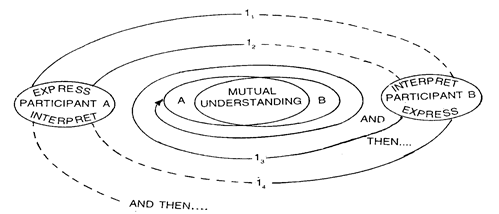
(Source: Communication networks by Everett M. Rogers and D. Lawrence Kinacid, 1981).
Feed Back in Communication
Feedback as a concept was developed in the 1940s and 1950's, when scientists began looking at the world in terms of systems model. They were interested in the nature of the systems, the applicability of system model to both the physical and social world.
Feedback is thus defined as information regarding actual performance or the result of the activities of a system. Not all information is feedback; only information which is used to control the future functioning of the system is considered feedback.
A system is a mechanism which obtains inputs from a larger environment, subjects the input to a transformation process, and then produces output. In this model, feedback is controlling information channel which connects the system's output with its input.
Importance of feedback
- Feedback is a basic component of self regulating system
- Feedback is information about the output of a system which controls the system input or transformation processes
- Feedback is any information about the system functioning which has the potential of being used to change the operation of the system.
- Viewing organizations as open systems, feedback is a necessary component, enabling the correction of errors, the adaptation to environmental change and learning.
- Since in social systems such as work organizations, feedback does not automatically create change in the system operation, the process of obtaining, interpreting and using feedback information is important.
- Since organizations often ignore feedback or do not make an effort to use feedback effectively, organizational development activities serve an important function of facilitating feedback processes, thus helping organizations to correct errors, adapt, learn and grow.
http://www.youtube.com/watch?v=Fpkm7D4Bn6I&feature=player_detailpage

